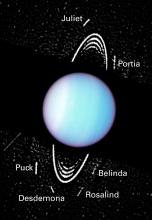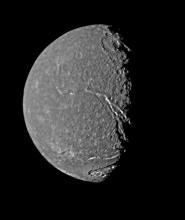Listen to today's episode of StarDate on the web the same day it airs in high-quality streaming audio without any extra ads or announcements. Choose a $8 one-month pass, or listen every day for a year for just $30.
You are here
Mars and Uranus
The giant planet Uranus hasn’t received a visit from Earth since 1986, when Voyager 2 gave us our only close-up view of the planet and its known moons. The spacecraft also found several new moons. And scientists recently have seen hints of two more satellites in the Voyager observations.
Uranus has 27 known moons. That’s a lot fewer than Jupiter and Saturn. Perhaps that’s because Uranus is smaller and less massive. Or perhaps it’s just harder to find moons because Uranus is farther away, and it’s farther from the Sun, so there’s less light to reveal its moons.
But scientists analyzing old Voyager data have found wavy patterns in two of the rings of Uranus. Each pattern may arise from the gravitational influence of a small, dark moon just beyond the ring. If the moons exist, they’re no more than a few miles across — smaller than any other Uranian moon yet seen.
Hubble Space Telescope may be able to find them. If not, though, a future mission to the planet may spot these elusive bodies — or else rule out their existence.
And with binoculars, the next few evenings offer a good chance to look for Uranus. Tonight, it stands close to the upper left of Mars, which itself is to the upper left of Venus, the “evening star.” Through binoculars, the solar system’s third-largest planet looks like a faint star, with perhaps a hint of blue-green. Mars and Uranus will stand almost side by side tomorrow night, with Mars above Uranus on Monday.
Script by Ken Croswell, Copyright 2016




